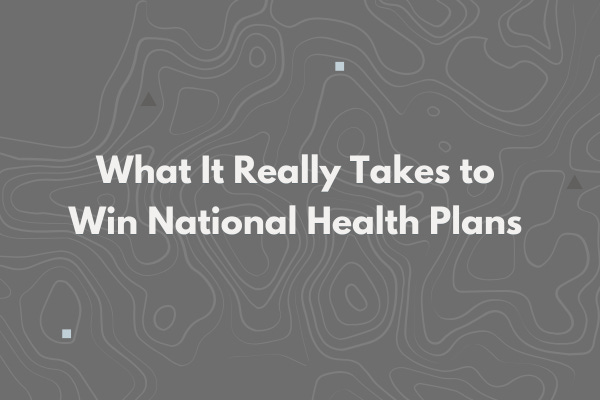What It Really Takes to Win National Health Plans
A clear-eyed guide for health tech vendors trying to break through with the largest buyers in healthcare.
Upward Growth provides health tech leaders with the playbooks and proof to transform complex markets into real growth. Each week, we deliver clear, practical strategies on positioning, messaging, and growth, so leaders can close enterprise deals and build repeatable momentum.
🟦 Connect with the author, Ryan Peterson, on LinkedIn.
📩 Join the CEOs, GTM leaders, and investors already reading every Tuesday.
💡 Sponsorship opportunities are available: Inquire here
Every vendor wants to have national health plans as clients.
Investors ask about them. Boards expect them. And for good reason. Landing a national health plan deal feels like a validation moment. Like the market is finally taking you seriously.
But the challenge to winning them isn’t just size, it’s structure. National health plans are matrixed, slow by design, and loaded with competing priorities. Even when a pilot gets greenlit, expansion often stalls because there’s no internal owner, no cross-functional air cover, and no urgency to scale.
That’s because landing a deal is just the first barrier. After that, you’re navigating three more obstacles, none of which have anything to do with your competition.
First: you’re fighting internal prioritization.
National plans are full of competing agendas. Stars, delegated risk, cost containment, and myriad internal initiatives are already lined up for the same pool of budget. Your champion may be sold on your solution, but if they don’t control the dollars, you’ll be stuck waiting for approvals that never come.
Second: macroeconomic pressure is making plans more cautious across the board.
Commercial payers are bracing for another wave of cost increases heading into 2026, forcing tighter scrutiny on anything outside the medical core.
Medicare Advantage is under similar strain: shrinking margins, policy shifts, and growing pressure to justify every supplemental dollar. National players are exiting markets, cutting benefits, and pulling back growth plans to preserve stability.
Medicaid, too, is facing real headwinds as the recently passed One Big Beautiful Bill slashes $1 trillion in funding, putting states and their Managed Care Organization (MCO) partners in defensive mode.
Affordable Care Act (ACA) plans are facing subsidy changes and premium hikes that are already reshaping their go-to-market strategy.
Third: even when the use case is clear, you’re up against internal alternatives.
Many national plans already have the staff, budget, or incentive to build in-house or simply extend existing platforms. If your value isn’t unmistakably clearer, faster, or more scalable than what they already have, you’re asking them to take a risk for no real upside.
This article is for vendor leaders trying to break into (or go deeper with) national health plans. I’ll unpack why mid-market success often doesn’t translate, what actually changes when you move upmarket, and how to build a Go-To-Market (GTM) motion that survives the scrutiny, complexity, and scale of national buyers.
Why Mid-Market Success Doesn’t Translate Up
Mid-market and regional plans are excellent customers and essential to building a healthy, durable foundation for growth. They often have urgent needs, less bureaucracy, and better access to leaders willing to move quickly on a good idea. The sales motion is typically relationship-driven, executive-led, and outcome-focused. If the plan sees clear ROI in a defined use case, it often requires less overall work to move forward.
That doesn’t mean national plans are inherently harder to work with. In many ways, they’re better positioned to fund innovation and have larger budgets and stronger incentives to improve quality and reduce cost. But they rarely start with scale. Most begin with a pilot or limited rollout in one market, one contract, or one line of business. And even when that goes well, expansion requires something entirely different. You’re no longer selling to a buyer, you’re navigating a system. And most vendors don’t realize how differently that system behaves until the opportunity starts slipping away.
The mistake is assuming national health plans are just like smaller ones, only slower to contract. In reality, the buying dynamics are fundamentally different. Nationals rarely move because of one executive’s (or market’s) conviction. They move because an initiative has cleared layers of review, aligns with enterprise priorities, and survives scrutiny from both corporate and market-level stakeholders while navigating a gauntlet of clinical, procurement, compliance, and finance requirements.
That doesn’t make national health plan buyers smarter; it makes them different. And if your GTM system isn’t designed for that difference, you’ll keep spinning your wheels.
What’s Different About Selling to National Plans
When vendors make the jump from regional success to national ambition, the challenge isn’t just selling into a bigger organization. It’s selling into a fundamentally different one. The buyer profile doesn’t just evolve, it fragments.
You’re no longer working with a single operating executive who owns their budget. You’re now in a layered environment where legal, compliance, IT, clinical, operations, finance, and procurement all have veto power (and often, competing priorities).
And the higher you go, the more your message gets filtered. What resonated with a regional VP now has to survive the inbox of a COO who’s never heard of you, a procurement lead tasked with reducing vendors, and an IT team scanning for risk vectors spanning cybersecurity to AI compliance to systems interoperability. Nationals don’t want to be educated from scratch. They want to validate, crosswalk, and move.
And the questions shift accordingly:
Not “What does this tool do?”
But “How many departments will need to touch this?”
Not “What’s the ROI in this contract?”
But “How do we operationalize this across 40 markets?”
Here are the three deal dynamics that change once you go national:
1. Your Buyer Persona Moves Up a Level
In mid-market plans, your buyer might make the decision. At nationals, they own the idea, but not the budget. Decisions often move through VP steering groups or portfolio review committees. Which means your message has to work up the chain. That’s where most vendors lose steam. They haven’t passed what I call the Message Ladder Test, or the ability for your story to remain compelling, legible, and defensible after being forwarded two or three times. If your buyer has to re-explain your value to the CFO or COO, you’ve already lost control of the narrative.
2. Proof Has to Scale Beyond a Single Win
National health plans don’t buy outcomes. They buy the ability to deliver those outcomes at scale. They need proof that your solution works across different markets, with minimal handholding and predictable lift. A Stars gain in Arizona won’t close a national deal, especially if it took a heroic effort to achieve. Unless you can show that your outcomes are repeatable and operationally feasible at scale, it becomes a nice isolated win, but not a strategic reason to expand.
“National health plans don’t buy outcomes.
They buy the ability to deliver those outcomes at scale.”
3. Procurement Becomes the Gatekeeper
Most vendors talk about “longer cycles” when they move upmarket, but that misses the point. Nationals have standardized intake processes built to reduce risk, not just compare options. Expect to be asked for SOC 2, HITRUST, executive indemnification language, prior audit history, and enterprise referenceability. Even your AI logic and decision criteria may get reviewed.
The upmarket shift introduces a different kind of selection process, one designed to identify vendors who can scale reliably across the enterprise. That’s where most stumble.
The Common Mistakes Vendors Make Going Upmarket
When a vendor gets their first shot with a national plan, whether it’s a pilot, a carve-out, or a regional deployment inside a larger system, there’s often a quiet assumption: if we prove it works, expansion will follow.
Proving value in one region or line of business doesn’t guarantee expansion. Most vendors stall because they don’t act like an enterprise partner from the start, and they miss the structural realities that shape how national plans actually buy.
Here’s where expansion efforts most often fall apart:
1. Misunderstanding how fragmented national plans actually are
You think you’re selling into a single health plan, but in reality, you’re selling into a federation. Each region or business unit may have different contracts, Stars targets, IT stacks, and leadership priorities. Just because you’ve won one geography or even have support from corporate does not mean expansion is automatic. If you don’t build for that internal complexity from the start, you’ll keep getting reintroduced like it’s your first call.
2. Overestimating internal momentum
You assume the buyer will carry the torch. However, the request is escalated to a steering committee or executive sponsor review without your presence in the room. Because your buyer doesn’t have a clean ROI model or a crisp one-pager to carry the case forward, your deal gets pushed to the next quarter or quietly cut when budgets tighten.
3. Selling to operations, not strategy
You anchor to a care gap, a call center workflow, or a Stars measure. It clicks with the operator. But there’s no translation to the portfolio-level business case. No answer to “What problem does this solve for the CFO?” As a result, your win becomes invisible at the level where funding decisions are made.
4. Failing to architect for expansion during the pilot
Most vendors treat the pilot as a proof of concept. Nationals treat it as a stress test. We see vendors focus on closing care gaps in a single market but never ask, “What will it take to deploy this in other H-contracts?” The pilot ends, and there is no shared blueprint for rollout.
These aren’t just tactical missteps. They reveal a more profound disconnect: a mindset misaligned with how national plans make decisions. Proving value is table stakes. Without a strategy to navigate internal complexity, align cross-functional support, and position for scale, even the best solutions go nowhere.
How to Build a Repeatable Motion That Wins National Plans
Most vendors treat national plan expansion like a bigger version of their mid-market playbook. But succeeding at scale requires an entirely different level of messaging, mobilization, and strategic patience.
As I’ve laid out, national plans buy differently. The decision path is longer, the stakeholders broader, and the narrative stakes higher. Your champion isn’t the buyer; they’re the narrator. And most vendors hand them the wrong script.
Below, I’ll break down the four operating disciplines that separate vendors who win national expansions with real-world examples, deal sequencing frameworks, and internal messaging templates.
The full playbook — including the sequencing framework, real buyer scenarios, and messaging moves that actually land with health plans — is just below. Upgrade to a paid subscription to keep reading.



